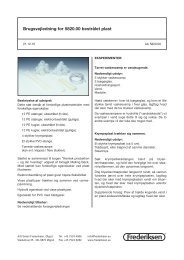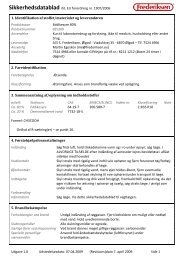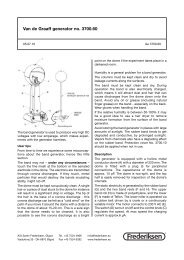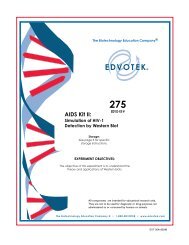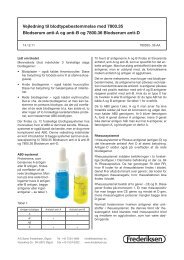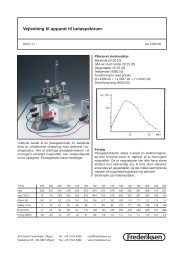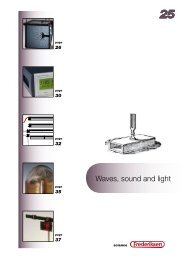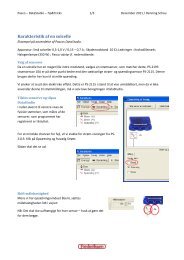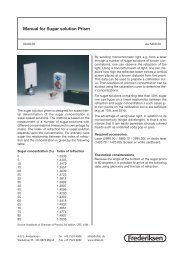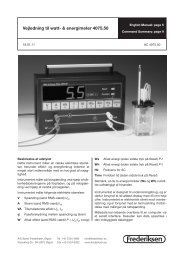255 - Frederiksen
255 - Frederiksen
255 - Frederiksen
- No tags were found...
Create successful ePaper yourself
Turn your PDF publications into a flip-book with our unique Google optimized e-Paper software.
Material Safety Data SheetsFull size (8.5 x 11”) pdf copy of MSDS available at www.edvotek.com or by request.EDVO-Kit #<strong>255</strong>25EDVOTEK®Material Safety Data SheetMay be used to comply with OSHA's Hazard CommunicationStandard. 29 CFR 1910.1200 Standard must be consulted forspecific requirements.IDENTITY (As Used on Label and List) Note: Blank spaces are not permitted. If any item is notapplicable, or no information is available, the space mustProtein InstaStainbe marked to indicate that.Section IManufacturer's NameEmergency Telephone NumberEDVOTEK, Inc.Address (Number, Street, City, State, Zip Code)14676 Rothgeb DriveRockville, MD 20850Telephone Number for informationDate Prepared05/07/07Signature of Preparer (optional)(301) 251-5990(301) 251-5990Section II - Hazardous Ingredients/Identify InformationHazardous Components [SpecificChemical Identity; Common Name(s)] OSHA PEL ACGIH TLVMethanol (Methyl Alcohol) 200ppm 200ppm No data 90%-100%CH3OHOther LimitsRecommended % (Optional)Section III - Physical/Chemical CharacteristicsBoiling Point65°CSpecific Gravity (H 0 = 1)2.79Vapor Pressure (mm Hg.)Vapor Density (AIR = 1)96mmHg1.11Melting PointEvaporation Rate(Butyl Acetate = 1)N/A4.6Solubility in WaterComplete (100%)Appearance and Odorchemical bound to paper, no odorSection IV - Physical/Chemical CharacteristicsFlash Point (Method Used)Flammable Limits LELUELExtinguishing Media(closed cup) 12°C 6.0% 36%Use alcohol foam, dry chemical or carbon dioxide. (Water may be ineffective)Special Fire Fighting ProceduresWear SCBA with full facepiece operated in positive pressure mode.Move containers from fireareaUnusual Fire and Explosion Hazards Vapors may flow along surfaces to distant ignition sources.Close containers exposed to heat may explode. Contact w/ strong oxidizers may cause fire.Section V - Reactivity DataStabilityUnstableConditions to AvoidStable X NoneIncompatibilityStrong oxidizing agentsHazardous Decomposition or ByproductsHazardousMay Occur Conditions to AvoidPolymerizationWill Not Occur X NoneSection VI - Health Hazard DataRoute(s) of Entry: Inhalation? Skin?Ingestion?Yes Yes YesHealth Hazards (Acute and Chronic) Irritating to eyes, skin, mucous membranes and upper respiratory tract.Chronic exposure may cause lung damage or pulmonary sensitizationCarcinogenicity: NTP? IARC Monographs?OSHA Regulation?No data No data No dataSigns and Symptoms of ExposureRespiratory tract: burning sensation. Coughing, wheezing, laryngitis, shortness of breath, headacheMedical Conditions Generally Aggravated by ExposureNo dataEmergency First Aid ProceduresSection VII - Precautions for Safe Handling and UseSteps to be Taken in case Material is Released for SpilledWaste Disposal MethodObserve all federal, state, and local laws.Carbon monoxide, Carbon dioxide, Sulfur oxidesFlush skin/eyes w/ large amounts of water. If inhaled, remove to fresh air. Ingestion: give large amountsof water or milk. Do not induce vomiting.Evacuate area. Wear SCBA, rubber boots and rubber gloves. Mop up w/ absorptive material and burn inchemical incinerato equipped w/ an afterburner and scrubber.Precautions to be Taken in Handling and StoringWear protective gear. Avoid contact/inhalation.Other PrecautionsStrong sensitizerSection VIII - Control MeasuresRespiratory Protection (Specify Type)NIOSH/MSHA approved respiratorVentilation Local Exhaust No Special Chem fume hoodMechanical (General) No OtherNoneProtective GlovesRubberEye ProtectionSplash-proof gogglesOther Protective Clothing or EquipmentRubber bootsWork/Hygienic PracticesAvoid prolonged or repeated exposureEDVOTEK®Material Safety Data SheetMay be used to comply with OSHA's Hazard CommunicationStandard. 29 CFR 1910.1200 Standard must be consulted forspecific requirements.IDENTITY (As Used on Label and List) Note: Blank spaces are not permitted. If any item is notapplicable, or no information is available, the space mustProtein Denaturing Solution be marked to indicate that.Section IManufacturer's NameEmergency Telephone NumberEDVOTEK, Inc.Address (Number, Street, City, State, Zip Code)14676 Rothgeb DriveRockville, MD 20850Telephone Number for information(301) 251-5990Date Prepared05/07/07Signature of Preparer (optional)(301) 251-5990Section II - Hazardous Ingredients/Identify InformationHazardous Components [SpecificChemical Identity; Common Name(s)] OSHA PEL ACGIH TLVSection III - Physical/Chemical CharacteristicsOther LimitsRecommended % (Optional)Lauryl Sulfate, Sodium No data No data No data No dataC12H26O4SCAS # 151-21-3Boiling PointNo dataSpecific Gravity (H 0 = 1)2No dataVapor Pressure (mm Hg.)Vapor Density (AIR = 1)No dataNo dataMelting PointEvaporation Rate(Butyl Acetate = 1)No dataNo dataSolubility in WaterSolubleAppearance and OdorBlue liquidSection IV - Physical/Chemical CharacteristicsFlash Point (Method Used)Flammable Limits LELUELExtinguishing MediaNo data No data No dataWater spray, Carbon dioxide, dry chemical powder, alcohol or polymer foamSpecial Fire Fighting ProceduresWear SCBA and protective clothing to prevent contact with skin and eyes.Unusual Fire and Explosion HazardsMay emit toxic fumes.Section V - Reactivity DataStabilityUnstableConditions to AvoidStable XNoneIncompatibilityStrong oxidizing agentsHazardous Decomposition or ByproductsHazardousPolymerizationWill Not OccurSection VI - Health Hazard DataMay Occur Conditions to AvoidRoute(s) of Entry: Inhalation? Skin?Ingestion?Yes Yes YesHealth Hazards (Acute and Chronic) Irritating to eyes, skin, mucous membranes and upper respiratory tract.Chronic exposure may cause lung damage or pulmonary sensitization resulting in hyperactive airway dysfunction.Carcinogenicity: NTP? IARC Monographs? OSHA Regulation?Not Known No data No data No dataSigns and Symptoms of Exposure Respiratory tract: Burning sensation, coughing, wheezing,laryngitis, shortness of breath, headache, nauseaMedical Conditions Generally Aggravated by ExposureEmergency First Aid ProceduresSection VII - Precautions for Safe Handling and UseSteps to be Taken in case Material is Released for SpilledCarbon Monoxide, Carbon Dioxide, Sulphur oxidesXNo dataNoneFlush skin/eyes with large amounts of water. If inhaled, remove to fresh air.Ingestion: Large amounts of water or milk. Do not induce vomiting.Evacuate area. Wear SCBA apparatus, rubber boots and rubber gloves. Mop upw/absorptive material and burn in chemical incinerator equipped w/ afterburner & scrubber.Waste Disposal MethodObserve all federal, state, and local laws.Precautions to be Taken in Handling and StoringWear protective gear. Avoid contact/inhalation.Other PrecautionsStrong sensitizerSection VIII - Control MeasuresRespiratory Protection (Specify Type)NIOSH/MSHA approved respiratorVentilation Local Exhaust No Special Chemical fume hoodMechanical (General) No Other NoneProtective GlovesRubber Eye Protection Splash proof gogglesOther Protective Clothing or EquipmentRubber bootsWork/Hygienic PracticesAvoid prolonged or repeated exposureEDVOTEK®Material Safety Data SheetMay be used to comply with OSHA's Hazard CommunicationStandard. 29 CFR 1910.1200 Standard must be consulted forspecific requirements.IDENTITY (As Used on Label and List) Note: Blank spaces are not permitted. If any item is notapplicable, or no information is available, the space mustColumn Elution Bufferbe marked to indicate that.Section IManufacturer's NameEmergency Telephone NumberEDVOTEK, Inc.Address (Number, Street, City, State, Zip Code)14676 Rothgeb DriveRockville, MD 20850Telephone Number for information(301) 251-5990Date PreparedSignature of Preparer (optional)(301) 251-599005/07/07Section II - Hazardous Ingredients/Identify InformationHazardous Components [SpecificChemical Identity; Common Name(s)] OSHA PEL ACGIH TLVOther LimitsRecommended % (Optional)This product contains no hazardous materials as defined by the OSHA HazardCommunication Standard.Section III - Physical/Chemical CharacteristicsBoiling PointNo dataSpecific Gravity (H 0 = 1)No data2Vapor Pressure (mm Hg.)No data Melting PointN/AVapor Density (AIR = 1)No dataEvaporation Rate(Butyl Acetate = 1)No dataSolubility in WaterSolubleAppearance and OdorClear liquid, no odorSection IV - Physical/Chemical Characteristics N.D. = No dataFlash Point (Method Used)Flammable Limits LELUELExtinguishing MediaNo dataCarbon dioxide, water sprayN.D. N.D.Special Fire Fighting ProceduresUse agents suitable for type of surroundingUnusual Fire and Explosion HazardsMay produce toxic gasesSection V - Reactivity DataStabilityUnstableStableConditions to AvoidX NoneIncompatibility copper, iron, silver salts, hydrogen peroxide, phenol, picric acid, formaldehydeether alcohol, nitrogen oxide, strong bases, oxidizing agentsHazardous Decomposition or ByproductsHazardousPolymerizationWill Not OccurSection VI - Health Hazard DataMay Occur Conditions to AvoidX NoneRoute(s) of Entry: Inhalation?Yes Skin? Yes Ingestion? YesHealth Hazards (Acute and Chronic) Toxicity has not been quantified. Sensitivity reactionsmay occur by skin penetration including anaphylactic shockCarcinogenicity:None identified NTP? IARC Monographs? OSHA Regulation?Signs and Symptoms of ExposureMedical Conditions Generally Aggravated by ExposureMay cause irritation to skin/eye, mucous membranes and upperrespiratory tractRespiratory conditionsEmergency First Aid ProceduresTreat symptomatically and supportivelySection VII - Precautions for Safe Handling and UseSteps to be Taken in case Material is Released for SpilledMop up with absorbant material. Dispose of properlyWaste Disposal Method Mix with vermiculite and dry caustic, wrap in paper and burn ina chemical incinerator equipped with afterburner and scrubber. Ignite in presence ofsodium carbonate and slaked limePrecautions to be Taken in Handling and StoringOther PrecautionsWear Protective gear to avoid skin/eye contact.Section VIII - Control MeasuresRespiratory Protection (Specify Type)Ventilation Local Exhaust Yes SpecialNoneMechanical (General) No Other Process Encl. Vent. Sys.Protective Gloves Yes Eye Protection Safety gogglesOther Protective Clothing or EquipmentProtection to avoid skin contactWork/Hygienic PracticesAvoid skin/eye contact and inhalation



